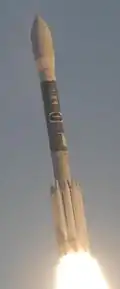Delta D
The Delta D, Thrust Augmented Delta or Thor-Delta D was an American expendable launch system used to launch two communications satellites in 1964 and 1965. It was derived from the Delta C, and was a member of the Delta family of rockets.
 Launch of a Delta D with Intelsat I | |
| Function | Expendable launch system |
|---|---|
| Country of origin | United States |
| Launch history | |
| Status | Retired |
| Launch sites | Cape Canaveral LC-17 |
| Total launches | 2 |
| Success(es) | 2 |
| First flight | 19 August 1964 |
| Last flight | 6 April 1965 |
The three-stage core vehicle was essentially the same as the Delta C. The first stage was a Thor missile in the DSV-2A configuration, and the second stage was the Delta D, which was derived from the earlier Delta. An Altair-2 SRM was used as a third stage. The main difference between the Delta C and Delta D was the presence of three Castor-1 solid rocket boosters, clustered around the first stage.
Both Delta D launches were conducted from Cape Canaveral Air Force Station Launch Complex 17A. The first, on 19 August 1964, carried Syncom 3, the first satellite in a geostationary orbit. The last, on 6 April 1965, carried the first commercial communications satellite, Intelsat I.
References
- Wade, Mark. "Delta". Encyclopedia Astronautica. Archived from the original on 2008-07-24. Retrieved 2009-02-09.
- Krebs, Gunter. "Thor family". Gunter's Space Page. Retrieved 2009-02-09.
